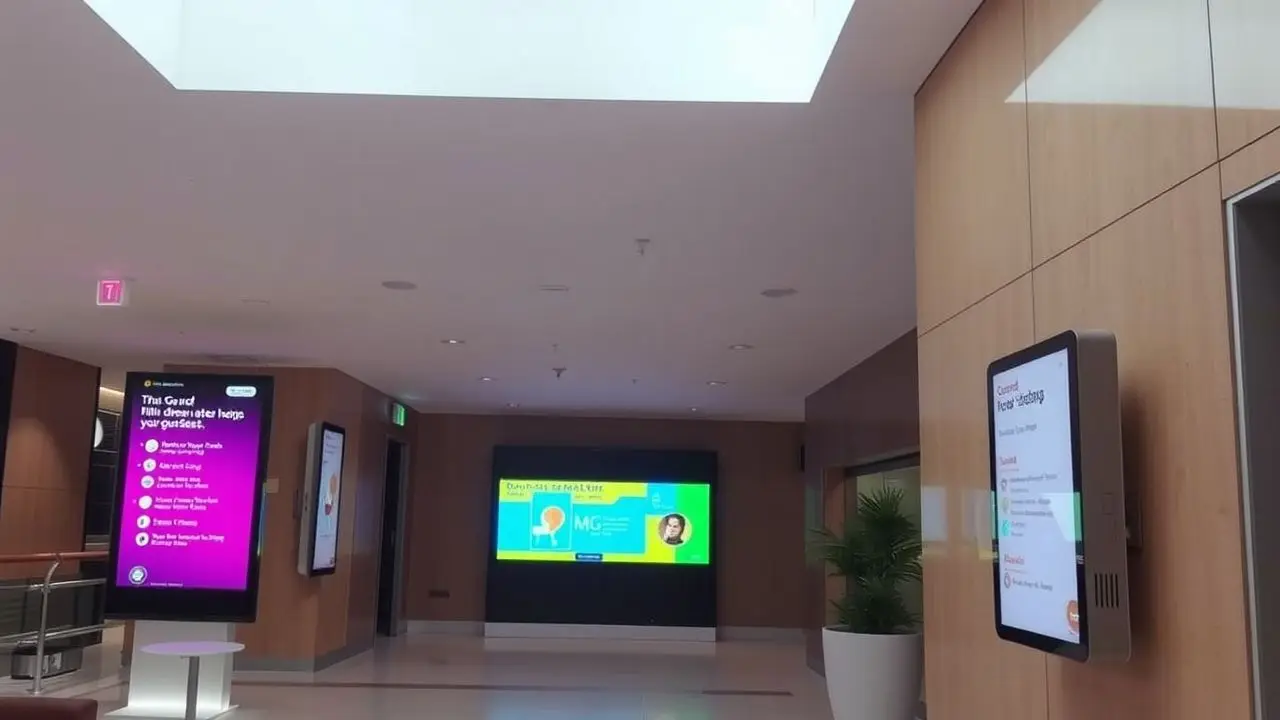Hotels want to make guests happy. A fact is, digital signage helps do this by changing the hotel guest experience. This blog will show how these signs make staying in hotels better and more fun.
Keep reading to learn more!
Key Takeaways
- Digital signage in hotel lobbies shows important info like check-in times and local events. This helps guests find what they need fast.
- These signs make hotels look modern. They share updates quickly and have interactive screens that let guests explore on their own.
- Using digital signs can help hotels work better. They show special deals and information without making guests wait or ask for help.
- Hotels choose the right technology for these signs to match what guests want. This includes touchscreens and mobile links.
- Digital signs also help with self-service, like checking in. Guests can do things on their own time, making their stay more fun.
Table of Contents
ToggleUnderstanding Hotel Lobby Digital Signage
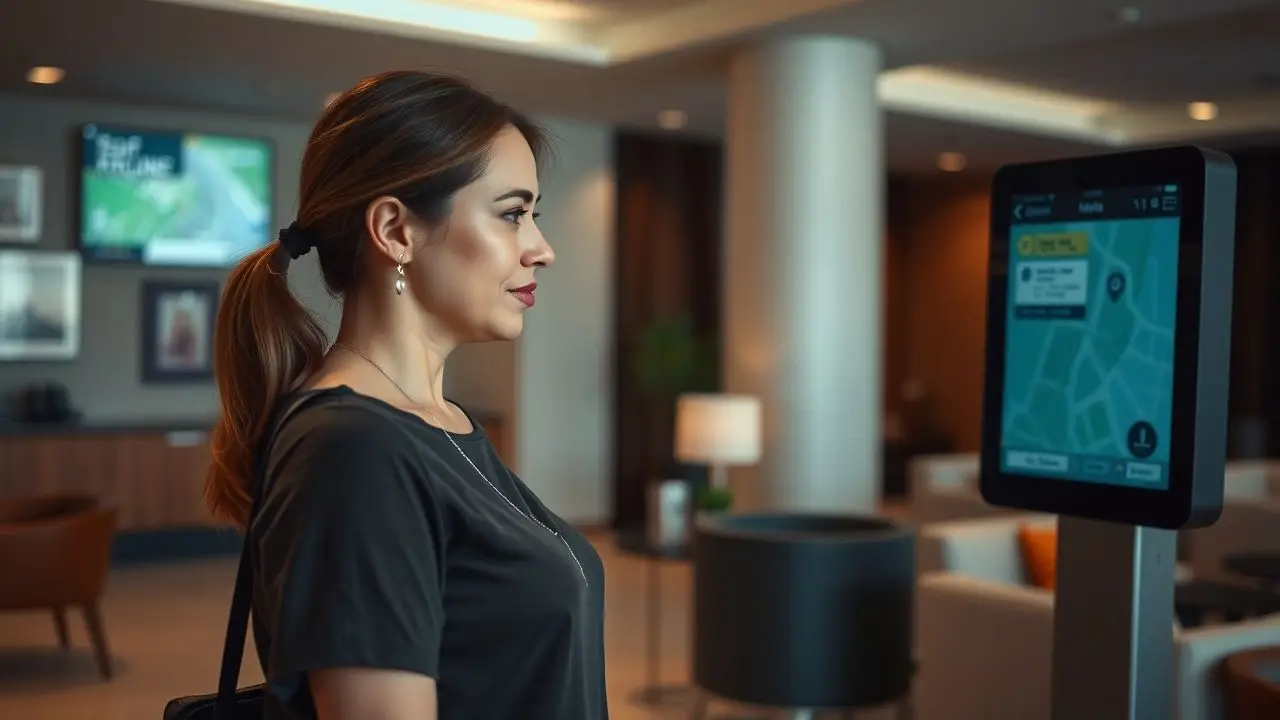
Digital signage in hotel lobbies shows important information to guests. It helps them find services and explore local attractions easily.
Definition

Hotel lobby digital signage refers to screens or displays found in hotel lobbies. These signs show important information for guests. They can display messages like check-in times, restaurant hours, and local events.
This technology improves guest satisfaction by offering real-time updates. It also creates a tech-savvy ambiance that attracts modern travelers. Digital signs allow hotels to share dynamic content quickly and efficiently.
Interactive displays engage guests and make their stay more enjoyable.
Benefits

Digital signage offers many benefits for hotels. It enhances guest engagement through real-time updates and interactive content. Guests can see promotional offers on screens as soon as they enter.
This tech-savvy ambiance makes a positive first impression and boosts customer satisfaction. Personalized messages also create a welcoming atmosphere that guests appreciate.
The use of digital displays streamlines operations within the hotel. Staff can quickly share important information with guests, reducing wait times and improving service efficiency.
Interactive kiosks provide self-service options for check-in or concierge services, saving time for both guests and employees. These changes help create a smooth experience in the hospitality industry while increasing marketing opportunities.
Implementing Hotel Lobby Digital Signage

Implementing digital signage in hotel lobbies can boost guest engagement. Choosing the right technology and creating effective content are key steps for success.
Choosing the right technology
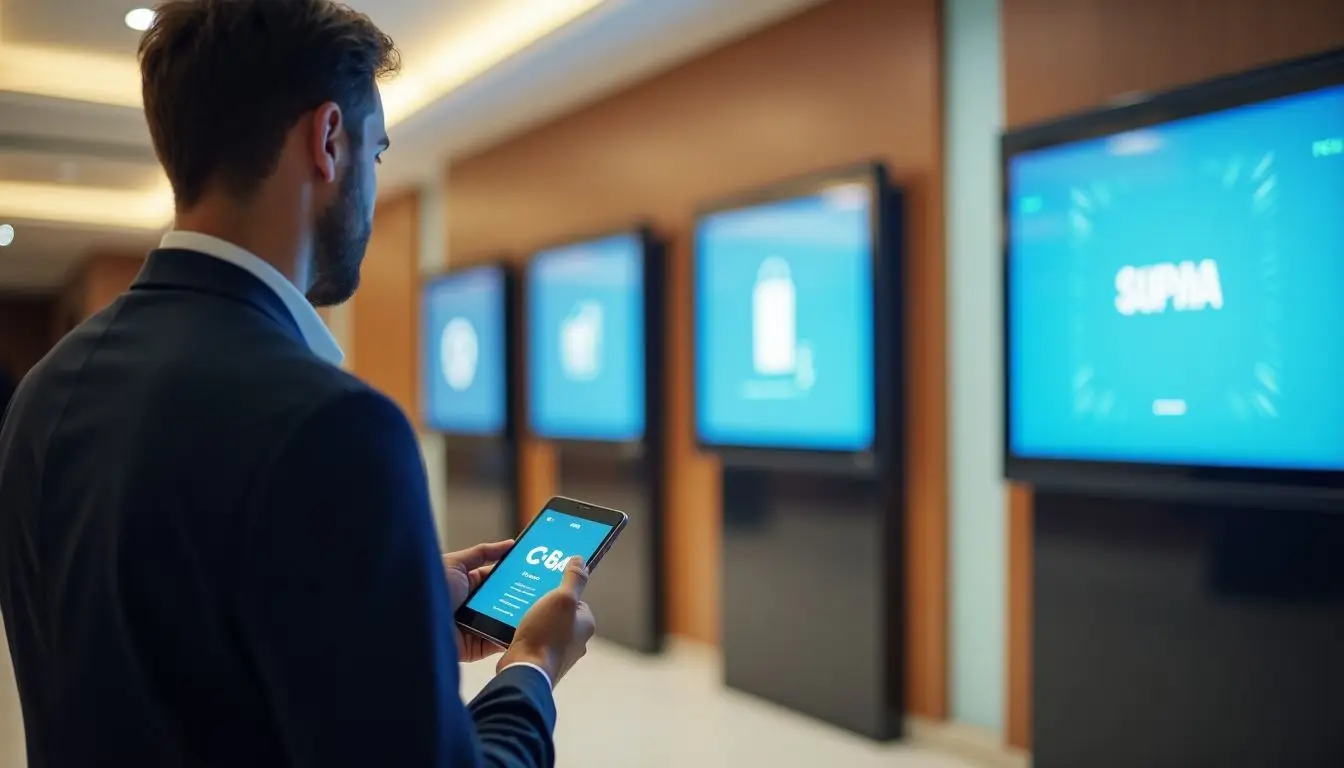
Digital signage can change how hotels interact with guests. Choosing the right technology is key to a great experience.
- Assess the hotel’s needs. Understand what messages will benefit guests most. This can include real-time updates or local attractions.
- Select hardware that fits your space. Screens need to be visible and easy to use. Consider size, placement, and brightness for any lighting conditions.
- Look for user-friendly software. The system should allow staff to update content quickly. Easy navigation keeps information current and engaging for guests.
- Ensure compatibility with existing systems. New tech should work well with current hotel services like booking systems or apps.
- Choose network options wisely. Reliable internet is crucial for quick updates and smooth operation of digital displays.
- Consider interactive capabilities. Touchscreens offer guests a smart service recommendation experience, improving customer satisfaction.
- Explore mobile integration features. Linking signage to guest smartphones can enhance interaction and provide personalized messages.
- Think about future growth while selecting tech solutions. Choose systems that allow upgrades as technology evolves in the hospitality industry.
- Factor in maintenance support from vendors before making a decision on tech providers, ensuring operational efficiency over time.
- Review case studies from similar hotels using digital signage successfully to learn about best practices and potential challenges they faced.
Content strategy
A strong content strategy is vital for hotel lobby digital signage. It ensures that messages are clear and engaging. Focus on what guests want to see. Use visuals and text to convey important information like events, dining options, or local attractions.
Interactive content can boost guest engagement. For example, touchscreens allow visitors to explore maps or make reservations. This tech-savvy ambiance makes the hotel feel modern and inviting.
Smart service recommendations help guests find exactly what they need in real-time updates.
Design considerations
Digital signage can greatly enhance the hotel guest experience. Good design helps grab attention and convey messages clearly.
- Size matters. Choose screens that fit the lobby space well. Bigger displays catch the eye, but they shouldn’t overwhelm the area.
- Positioning is key. Place signs where guests can easily see them. High traffic areas work best for maximum visibility.
- Brightness impacts usability. Outdoor screens need high brightness to be clear in sunlight. Indoor screens should be bright enough to stand out without being harsh on the eyes.
- Content affects engagement. Use interactive content to draw guests in. This leads to a tech-savvy ambiance and keeps guests informed or entertained.
- Color choices matter. Use colors that match the hotel’s theme and branding well. Clear contrast between text and background improves readability.
- Font selection is crucial. Opt for simple fonts that are easy to read from a distance. Avoid overly decorative styles that could confuse guests.
- Animation needs balance. Short animations can catch attention but should not distract too much from important information.
- Regular updates are essential. Keep content fresh with real-time updates on events, offers, or services available within the hotel.
- Accessibility is vital for all guests, including those with disabilities or language barriers; provide options such as multiple languages or adjustable text sizes.
Consider all these elements while implementing digital signage systems in hotels to create a better customer experience and streamline operations effectively!
Overcoming challenges
Digital signage can change how hotels serve their guests. It also comes with some challenges.
- Cost concerns can be a major issue. Hotels need to invest in technology and content. This may seem high, but it can pay off in the long run through better guest experiences and increased revenue.
- Staff training is vital for success. Team members must understand how to use the new systems. If they do not, the technology might not work correctly. Staff should feel confident when helping guests.
- Content management can be tricky. Updating visuals and messages takes time and effort. Hotels must create fresh content regularly to keep guests informed and engaged.
- Technical issues may arise at any time. Problems like slow connections or broken screens can frustrate guests. Having reliable tech support is important to fix ongoing problems quickly.
- Choosing the right display location matters greatly. Poor placement could lead to low visibility or distractions for guests. Thoughtful placement ensures that visuals reach as many people as possible.
- Guest privacy concerns are another hurdle to overcome. Personalization is key, but not at the cost of guest trust. Hotels must find a balance between engagement and respect for guest information.
- Keeping up with trends in visual communication is necessary for success in digital signage efforts within hotels; staying updated with new designs will attract more attention from tech-savvy travelers.
- Competition from nearby hotels can present challenges too; effective marketing strategies using digital signage must stand out to draw in visitors looking for a unique experience focused on modern innovation.
Enhancing Guest Experiences
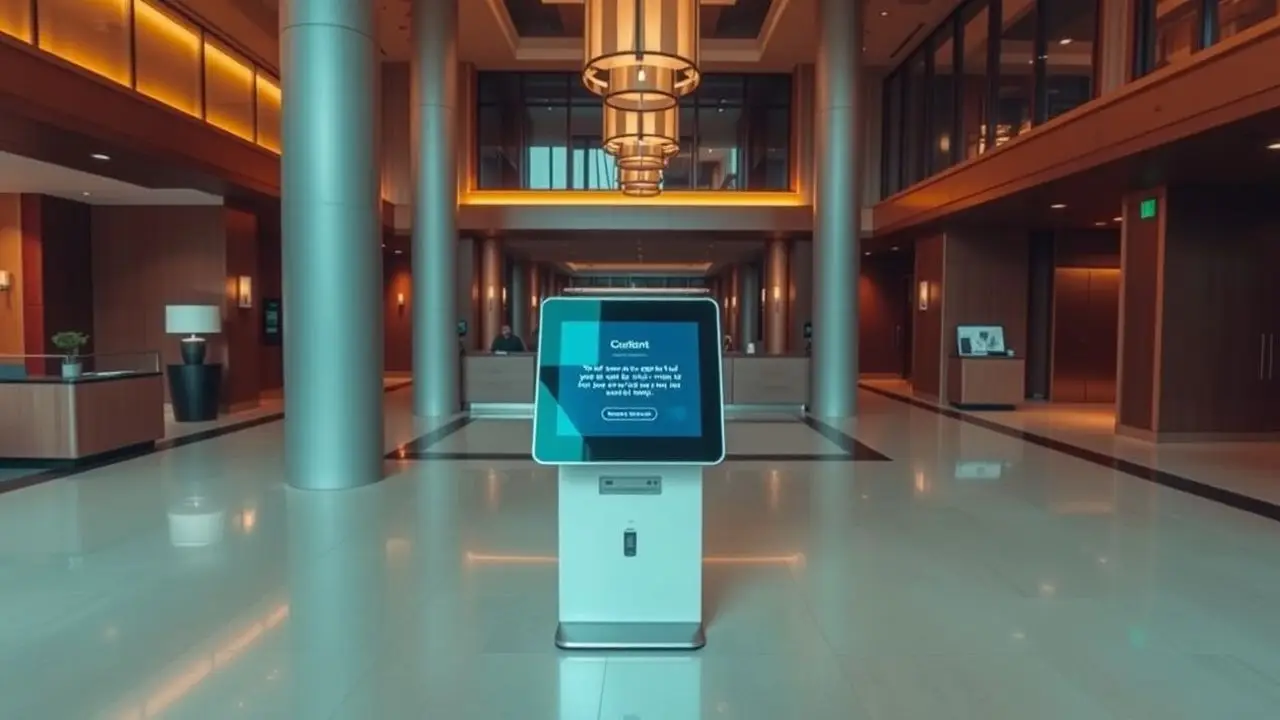
Digital signage brings interactive tools that let guests engage in new ways. They can find information easily and receive messages just for them. This makes their stay more enjoyable and personal.
Want to learn how these changes affect hotel stays? Keep reading!
Interactive engagement
Interactive engagement changes how guests enjoy their stay at hotels. Guests can use screens to explore services and find information quickly. Touchscreens allow visitors to check in or look up local attractions easily.
These tools create a tech-savvy ambiance that keeps guests interested. They get real-time updates on events, dining options, and special offers right at their fingertips. First-hand experience shows that this makes the hotel feel modern and welcoming.
Guests appreciate personalized messages displayed just for them, adding a special touch to their visit.
Personalized messages
Hotels can use digital signage to send personalized messages to guests. This creates a tech-savvy ambiance that makes visitors feel special. For example, welcome screens can greet guests by name as they check in.
They may also show activities happening at the hotel or nearby attractions tailored to guest interests.
These messages keep guests informed with real-time updates. Digital signs can share restaurant specials, event schedules, and travel tips based on where the guest is coming from. Offering custom information enhances their stay and makes it memorable.
Personalization adds value and builds a stronger connection between the hotel and its guests.
Self-service options
Self-service options improve the hotel guest experience. Digital signage offers easy access to information. Guests can check in or out without waiting. They can view room availability and make bookings right on a screen.
Interactive kiosks help guests find local attractions, dining, or services easily. These self-service tools give real-time updates about events and hotel activities. This tech-savvy ambiance makes the stay more enjoyable for everyone involved.
Streamlining Hotel Operations
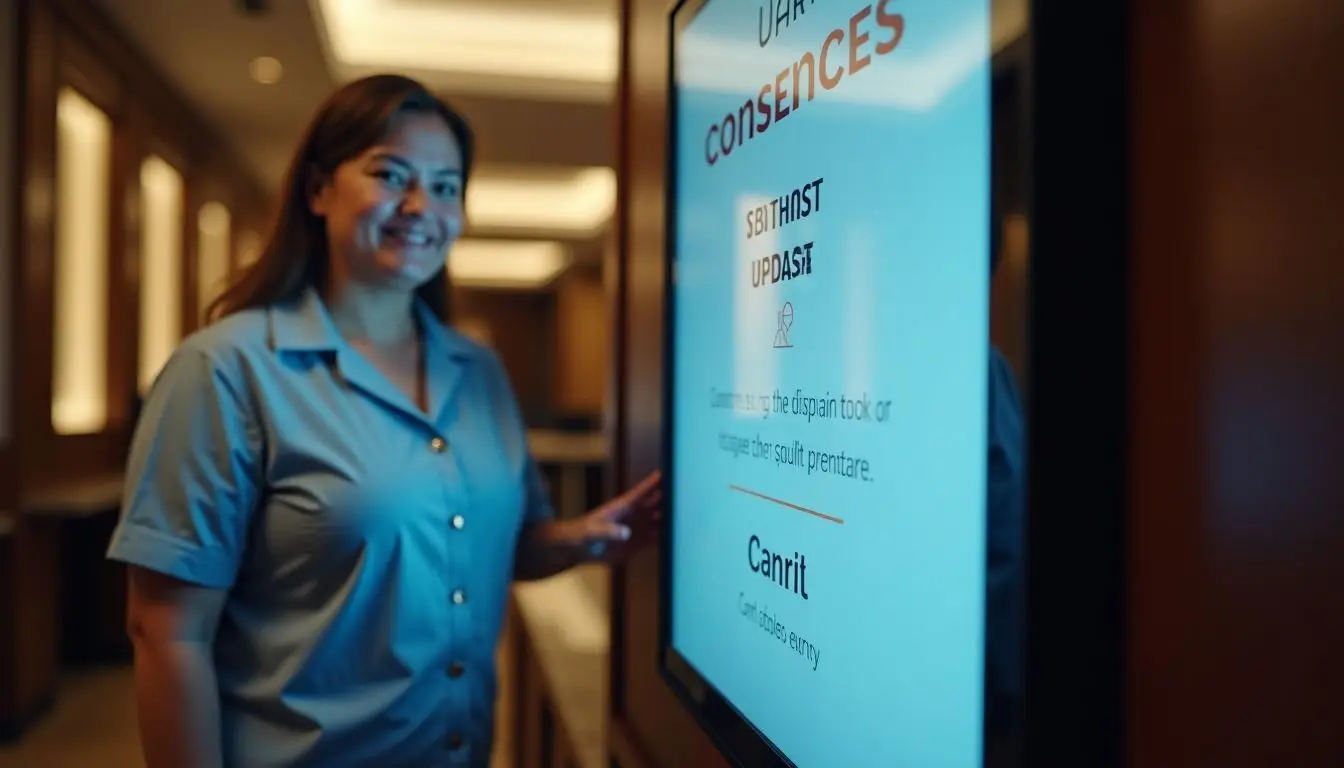
Digital signage helps hotels market their services and boost revenue. It makes operations smoother by providing real-time updates to guests and staff.
Marketing and revenue opportunities
Hotels can use digital signage to boost marketing and revenue. These displays show real-time updates for events, promotions, and services. Guests can see special offers on dining or spa packages right away.
This tech-savvy ambiance draws in more guests and encourages spending.
Electronic signage helps hotels advertise their own services too. For instance, a hotel may promote its business meeting spaces to local companies. Interactive kiosks display information about nearby attractions or tours that guests might enjoy.
All these features improve the guest experience while increasing profits at the same time.
Boosting operational efficiency
Digital signage boosts operational efficiency in hotels. Staff can update information quickly. This includes changes to schedules or special offers. Guests see real-time updates on screens as they walk through the lobby.
It saves time and cuts down on phone calls.
Interactive kiosks serve guests efficiently too. They can check in or find local attractions without help from staff. This reduces wait times and improves guest satisfaction. Technology innovation makes these processes smoother and faster, creating a tech-savvy ambiance for all visitors.
First-hand experience shows that many guests appreciate self-service options, allowing them to enjoy their stay more fully.
Interactive kiosks for concierge services
Interactive kiosks improve concierge services in hotels. They provide guests with quick answers to their questions. These kiosks offer maps, restaurant options, and local attractions.
Guests can get real-time updates about events and activities nearby.
Using these kiosks creates a tech-savvy ambiance for visitors. Self-service options help guests find what they need without waiting in line. This enhances the overall guest experience by making information easily accessible at any time.
Digital displays for business meetings
Digital displays for business meetings play a crucial role in hotels. They provide real-time updates about schedules and room changes. Guests can quickly find information they need without asking staff.
This tech-savvy ambiance helps create a smooth experience during events.
Using electronic signage makes meetings more effective. Attendees appreciate clear visuals and easy access to details. Digital displays also allow hotels to promote services or nearby attractions during breaks.
First-hand experience shows that these tools enhance guest satisfaction and streamline hotel operations well.
Conclusion
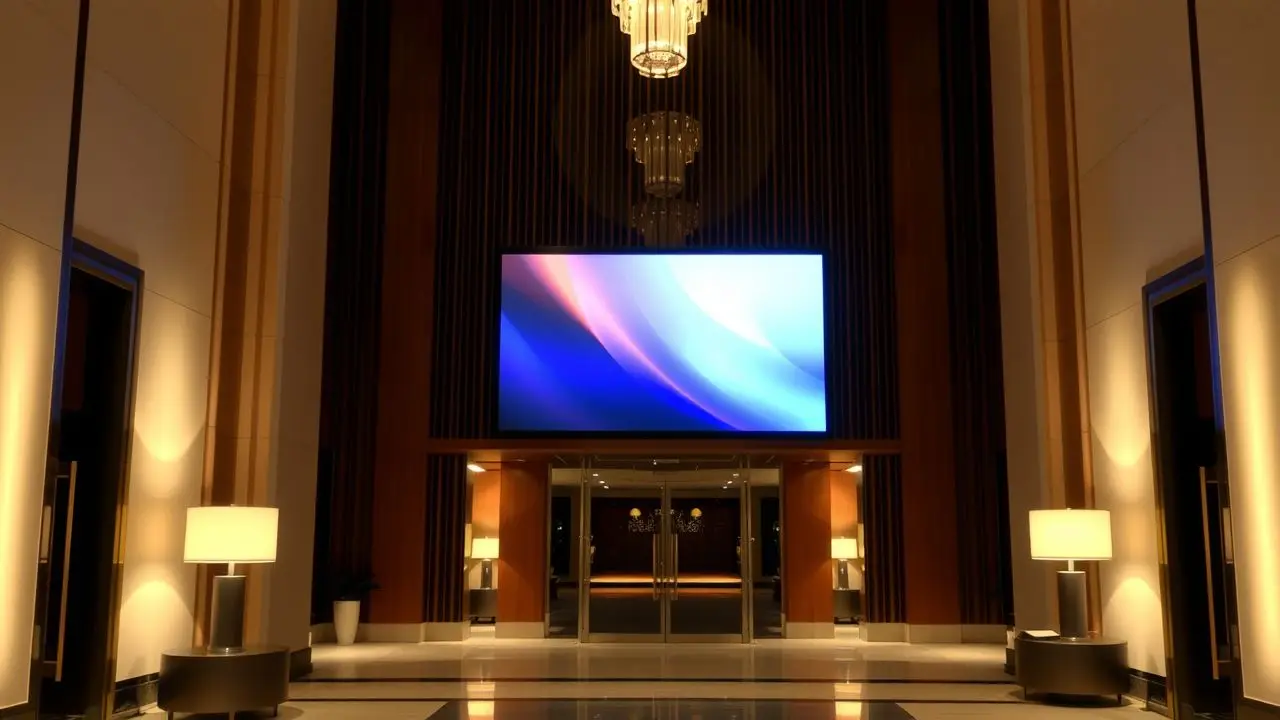
Digital signage changes how hotels connect with guests. It offers real-time updates and personalized information. Guests find what they need quickly and easily. This tech-savvy approach makes their stay more enjoyable.
Hotels also see better marketing opportunities and efficient operations. Overall, digital signage is key to improving the guest experience.
FAQs
1. How is digital signage revolutionizing the hotel guest experience?
Digital signage is transforming the hotel guest experience by offering a tech-savvy ambiance and providing real-time updates, enhancing the overall stay.
2. What benefits does a tech-savvy ambiance provide in hotels?
A tech-savvy ambiance created through digital signage helps to modernize hotels, making them more appealing to guests who value up-to-date technology and convenience.
3. How do real-time updates enhance the guest experience in hotels?
Real-time updates displayed on digital signs keep guests informed about important information like weather forecasts or local events, improving their stay and satisfaction with the hotel services.
4. Can you explain how this is part of a larger digital transformation in hospitality?
Yes, implementing digital signage is part of a broader trend towards digitization in hospitality that aims to improve customer service, streamline operations and create memorable experiences for guests.
